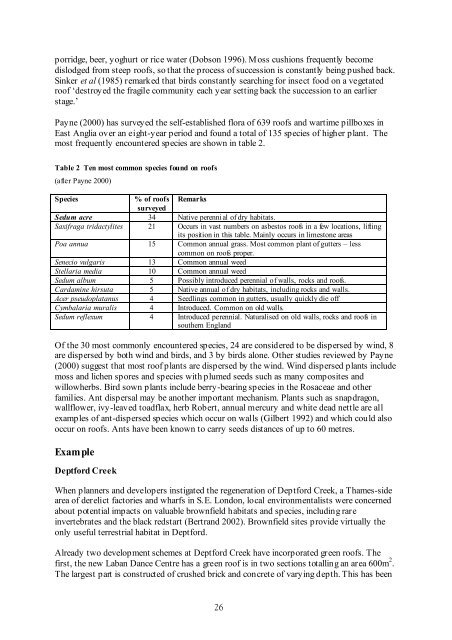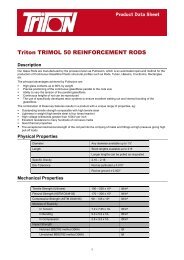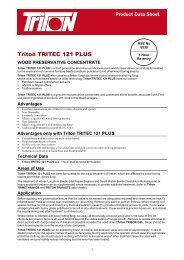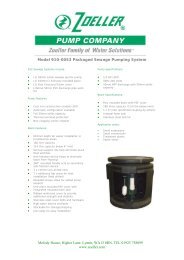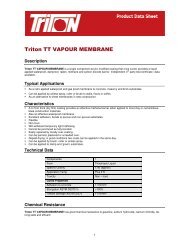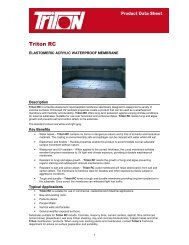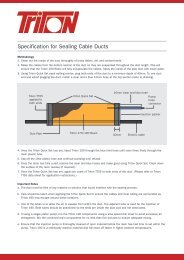Green Roofs - GreenSpec
Green Roofs - GreenSpec
Green Roofs - GreenSpec
- No tags were found...
You also want an ePaper? Increase the reach of your titles
YUMPU automatically turns print PDFs into web optimized ePapers that Google loves.
porridge, beer, yoghurt or rice water (Dobson 1996). Moss cushions frequently becomedislodged from steep roofs, so that the process of succession is constantly being pushed back.Sinker et al (1985) remarked that birds constantly searching for insect food on a vegetatedroof ‘destroyed the fragile community each year setting back the succession to an earlierstage.’Payne (2000) has surveyed the self-established flora of 639 roofs and wartime pillboxes inEast Anglia over an eight-year period and found a total of 135 species of higher plant. Themost frequently encountered species are shown in table 2.Table 2 Ten most common species found on roofs(after Payne 2000)Species% of roofs RemarkssurveyedSedum acre 34 Native perennial of dry habitats.Saxifraga tridactylites 21 Occurs in vast numbers on asbestos roofs in a few locations, liftingits position in this table. Mainly occurs in limestone areasPoa annua 15 Common annual grass. Most common plant of gutters – lesscommon on roofs proper.Senecio vulgaris 13 Common annual weedStellaria media 10 Common annual weedSedum album 5 Possibly introduced perennial of walls, rocks and roofs.Cardamine hirsuta 5 Native annual of dry habitats, including rocks and walls.Acer pseudoplatanus 4 Seedlings common in gutters, usually quickly die offCymbalaria muralis 4 Introduced. Common on old walls.Sedum reflexum 4 Introduced perennial. Naturalised on old walls, rocks and roofs insouthern EnglandOf the 30 most commonly encountered species, 24 are considered to be dispersed by wind, 8are dispersed by both wind and birds, and 3 by birds alone. Other studies reviewed by Payne(2000) suggest that most roof plants are dispersed by the wind. Wind dispersed plants includemoss and lichen spores and species with plumed seeds such as many composites andwillowherbs. Bird sown plants include berry-bearing species in the Rosaceae and otherfamilies. Ant dispersal may be another important mechanism. Plants such as snapdragon,wallflower, ivy-leaved toadflax, herb Robert, annual mercury and white dead nettle are allexamples of ant-dispersed species which occur on walls (Gilbert 1992) and which could alsooccur on roofs. Ants have been known to carry seeds distances of up to 60 metres.ExampleDeptford CreekWhen planners and developers instigated the regeneration of Deptford Creek, a Thames-sidearea of derelict factories and wharfs in S.E. London, local environmentalists were concernedabout potential impacts on valuable brownfield habitats and species, including rareinvertebrates and the black redstart (Bertrand 2002). Brownfield sites provide virtually theonly useful terrestrial habitat in Deptford.Already two development schemes at Deptford Creek have incorporated green roofs. Thefirst, the new Laban Dance Centre has a green roof is in two sections totalling an area 600m 2 .The largest part is constructed of crushed brick and concrete of varying depth. This has been26


